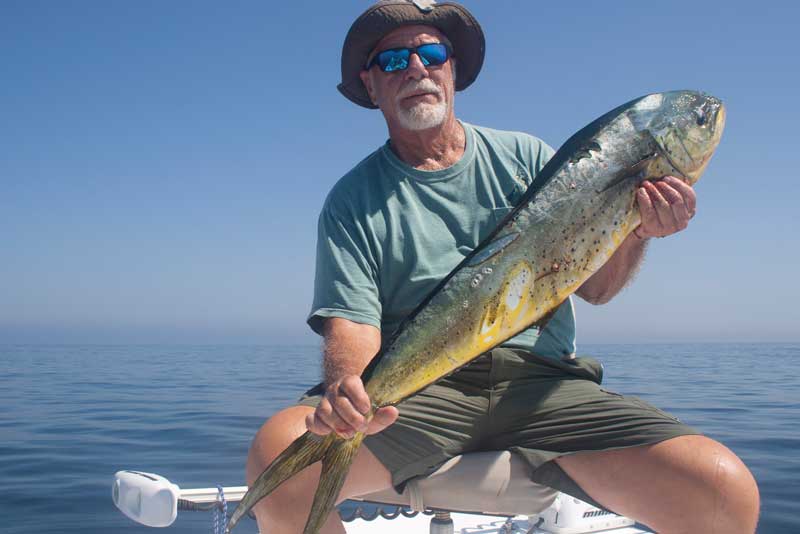While people spend a lot of time and money chasing tuna and marlin (when they could be chasing dolphin!) in the canyons off the DelMarVa Coast, there is no getting around the fact that cranking on a 100-pound tuna or a 250-pound blue marlin is nothing short of hard work. Sure, the adrenalin kicks in and you really don’t realize how hard you are working until the fight gets into the late rounds, but by then it’s too late to throw in the towel. Once the mate sinks the gaff in the tuna or sets the marlin free and you collapse in the fighting chair or on the deck, do you even know just how much fun you had?

Then, there are dolphin. These fish are generally smaller than tuna or marlin and show up in great numbers willing to take just about anything they see. They will put on an aerial show that rivals any marlin, and their meat is delicious.
If there is one benefit of global warming, it is the fact that we can now find dolphin closer to shore than we did just a few years ago. I have caught them at the Del-Jersey-Land Reef out of Indian River Inlet and at the Jackspot out of Ocean City. My son Ric has caught them close to shore over wrecks out of Virginia Beach.
One of the more interesting methods to catch is sort of live lining minnows. I came up with this idea a couple of years ago when we were planning a sea bass trip to the Del-Jersey-Land Reef.
We had the usual clams and squid baits plus a few jigs that we always carry for sea bass, and I brought along my minnow bucket with the same bullheads that I would normally use for flounder. We were fishing on Larry Weldin’s boat, and Mike Pizzolato was also onboard.
Once we arrived at the reef site and set up for sea bass, I rigged up a spinning rod with a single circle hook and a live minnow. I fed that out the stern with no weight and let the bait swim free.
We marked a ton of sea bass over the structure, but none of them were interested in our bait or jigs. Then, I noticed my spinning rod was doubled over and a dolphin was jumping off the stern. I grabbed it out of the rod holder and reeled in a nice bailer dolphin.
The rod was reset with another live minnow, and it wasn’t long before it went off again. This time Larry was up, and this time the dolphin was much bigger. The fish put on a show, and I was able to put the gaff in a beautiful 15-pound fish. Our third dolphin was about the same size as the first, and Larry brought that one in as well.
With the uncooperative sea bass—Mike had caught one, Larry and I didn’t have so much as a bite—Larry wanted to try trolling, thinking we could catch some more dolphin. We should have stayed with the live minnows. Trolling produced nothing.
In hindsight, I think we should have stayed with the minnows and tossed a few over like live chum. That would have drawn in any dolphin over the reef, and I believe we could have caught even more.
When looking for dolphin in the canyons, try to find Sargassum weed. The thicker the better. If you find a large, thick patch, stop trolling and begin casting chunks of ballyhoo, or whatever baits you have, to the fish under the weed. I have caught a three-man limit by doing this when I ran charters out of Virginia Beach.
Some captains will leave one fish in the water to hold the others close. I have tried this and find tossing bits of bait works just as well or even better as it puts the dolphin in a feeding frenzy.
When trolling for marlin and tuna, don’t pass up the chance to pull baits or lures past any floating object. This is where you just might find a larger dolphin or even a wahoo.
In addition to being fun to catch, dolphin are great to eat. You can fix them any way you enjoy fish. The meat is firm and white, and even the larger fish don’t have a strong flavor.
I like to fry mine up with a bit of Old Bay and butter. Other folks use them in tacos.
By Eric Burnley